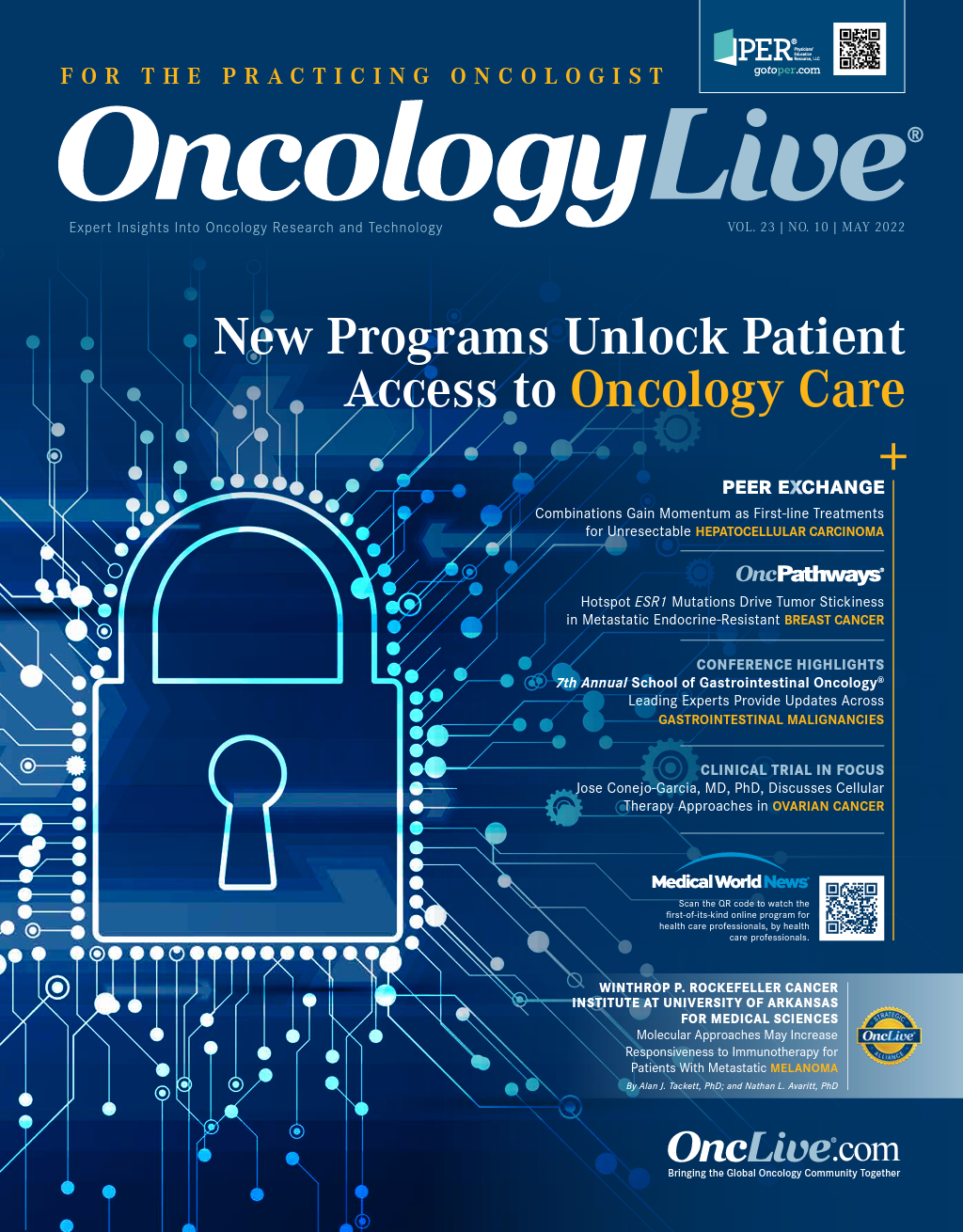Innovations in Patient-Reported Outcomes Lead to Better Care
For decades in cancer care, the compiling of patient-reported outcomes was limited to simple standardized questionnaires completed with pen and paper.
Ishwaria M. Subbiah, MD, MS

For decades in cancer care, the compiling of patient-reported outcomes (PROs) was limited to simple standardized questionnaires completed with pen and paper. They were designed to give clinicians a general idea of how a diagnosis of cancer and the corresponding treatment regimen affected patients mentally and physically. However, the collection of PROs and their application to treatment decisions has rapidly evolved over recent years, leading to more personalized and effective treatment regimens for patients with cancer.
“PROs are where a question is asked of the patient and the patient responds in an unassisted way,” said Ishwaria M. Subbiah, MD, MS, a medical oncologist and palliative care and integrative medicine physician at The University of Texas MD Anderson Cancer Center (MD Anderson) in Houston, in an interview with OncologyLive®.
PROs encompass a wide variety of signs, symptoms, and feelings. Examples in clinical oncology practice include the measuring of pain, daily activity levels, appetite, and dietary habits, among many others, with new innovations making their reporting more accurate, instantaneous, and clinically effective.
PRO Innovations Affecting Clinical Practice and Outcomes
The telehealth revolution spurred by the COVID-19 pandemic has touched nearly every aspect of cancer care and health care in general, and PROs are no exception. Mobile apps, online platIshwaria M. Subbiah, MD, MS forms, artificial intelligence–driven algorithms, and other innovations aimed at gathering PROs in a more convenient way for patients and clinicians are becoming commonplace.
“Technology has penetrated health care in a way that is unprecedented when it comes to the patients,” Subbiah said. “On the back end, as clinicians, we have seen how technological advances change how we deliver health care, as well as how we transmit information amongst clinical teams and across institutions.”
An effective new entry in PRO collection has arrived in the form of online reporting software, such as the electronic patient self-Reporting of Adverse-events: Patient Information and aDvice (eRAPID) system. eRAPID is designed to provide patients with a secure online platform that is accessible from their home computer or other internet-capable device. The system is programmed with an automated clinical algorithm which delivers advice for symptom management or a prompt to call for assistance based on symptom severity.1
Investigators evaluated eRAPID in a phase 3 trial (ISRCTN88520246) in combination with standard care in 508 patients with mostly early-stage cancers who were being treated with curative intent. The trial included patients with colorectal, breast, or gynecological cancers who were planning to receive chemotherapy and had internet access. The investigators randomly assigned the patients 1:1 to receive either standard care (n = 252) or standard care plus eRAPID (n = 256).
In the study, standard care included receiving verbal and written treatment information during in-person visits with an oncologist, regular assessment via telephone or in clinic, and contact with the hospital using an emergency hotline. Patients in the experimental arm completed online symptom-related questions from home over a period of 18 weeks, with weekly reminders being sent via text message and email. The patients’ symptom reports were relayed to their care team in real time using an electronic patient records system.
The primary end point of the trial was symptom control assessed by the Functional Assessment of Cancer Therapy-General, Physical Well-Being subscale at 6, 12, and 18 weeks. Secondary end points included processes of care, patient self-efficacy, and quality of life.
Results from the trial showed that eRAPID had a significant effect on improving patient physical well-being and self-efficacy and did not lead to a significant increase in hospital workload. eRAPID use led to improvement in physical well-being compared with usual care at 6 weeks (P = .028) and 12 weeks (P = .039). Patients who used eRAPID also had less clinically meaningful deterioration of physical well-being at 12 weeks vs patients who received usual care (47% vs 56%).
The average patient adherence with weekly symptom reporting was 64.7%. Although eRAPID participation was not associated with a difference in process of care, patients who used the intervention reported better overall health-related quality of life by the EQ visual analogue scale at 12 weeks (P = .0095) and 18 weeks (P = .0302) compared with those who received usual care (TABLE1).
“PROs are impactful when they measure symptoms,” Subbiah said. “Where the impact has truly been dramatic is when patients are asked this question remotely between clinic visits when they are not face to face with a health care team member. Through remote symptom monitoring, patients can mark how they are doing specifically using numbers. When we receive that information as a clinical team, we can see where their symptom intensity is today compared with where it was yesterday, or a week ago, or 2 weeks ago. This is important because then you can pick up changes in how they are doing when the change is subtle vs when it is more severe.”
PRO reporting systems designed specifically for mobile device apps have also gained traction as smartphones have become increasingly commonplace among patients of all ages. One such app is SeamlessMD, a Health Insurance Portability and Accountability Act–compliant cloud-based platform that enables clinicians to provide patients with education and symptom monitoring services that patients can access via their smartphone.2
Kneuertz et al tested the utility of SeamlessMD for patient engagement and PRO assessment following robotic surgery for lung cancer. The app was customized to cater to the requirements of the thoracic enhanced recovery pathway and included measures for preoperative preparation, in-hospital recovery, and postoperative discharge care.
The study included 50 adult patients with a diagnosis of or suspected lung cancer who were scheduled for robotic lung resection. SeamlessMD was made available on Apple and Android devices and the study allowed patients to designate a proxy, such as a spouse or child, if they were unable to use the app by themselves. Questions and tasks prompted on SeamlessMD were personalized to the needs of the individual patient and included daily symptom assessments, educational measures, exercise regimens, and recovery progress checks. Of 20 patients who returned the preoperative adherence survey, 85% reported receiving wound education and 95% adhered to some or all of the daily exercise programs. The postoperative health reports were completed by 27 patients, with a median of 3 (range, 0-17) completed surveys per patient.
Results from the postoperative health checks showed that the intervention was effective at improving patients’ confidence in their treatment regimen: 85.2% of patients reported improved confidence and 81.5% expressed decreased levels of worrying after completing the checks. A significant number of patients (40.9%) also said that the app’s health checks helped them avoid 1 or more phone calls to their care team, and 18.2% of patients said the checks helped them avoid at least 1 hospital visit.
Overall, patient satisfaction with SeamlessMD was high; 74.2% of patients who completed the preoperative survey (n = 31) found the app very helpful in terms of preparing themselves for their procedure. Among patients who completed the in-hospital survey (n = 31), 74.2% found the app extremely useful or very useful while they were in the hospital. Finally, after discharge, most of the 33 patients who were surveyed (78.8%) found SeamlessMD extremely or very useful post discharge and all patients said they would definitely or probably recommend the app. “There are many third-party applications that are in this space,” Subbiah noted. “The common theme [among them] is they want it to be as user friendly as possible for the patients. They want to ask good questions so that you get answers that, as a clinical team member, [you can] actually interpret and use.”
Effectively applying PRO measures, both new and old, is not without its challenges for clinicians, patients, and institutions. According to Subbiah, factors such as a patient’s comfort level with and access to necessary technology, accuracy in the self-reporting of symptoms, and the variety and differences among PRO collection methods all serve as potential barriers to effectively harnessing PROs.
To address some of the challenges presented by PROs, MD Anderson formed the Patient Survey Informatics Committee, which Subbiah chairs. The committee is tasked with overseeing the implementation of PROs across the institution and applying them to clinical practice and grew out of a need for remote symptom monitoring oversight and guidance.
Oncologists, patient experience team members, patient educators, clinical nurses, and legal team members all have a presence on the Patient Survey Informatics Committee, Subbiah noted. He added that the committee works to refine how questions are presented to patients, ensure with clinicians that questions are clinically validated, avoid question redundancy, and optimize workf lows related to PROs.
The Next Step for PROs
According to Subbiah, a major innovation ongoing in the realm of PROs is their increasing synchronicity with biometric data. By definition, PROs are written responses; however, Subbiah argues that dynamic PRO capture methods that take into account changes the patient may not immediately recognize themselves can increase the speed and quality of care.
“[PROs] can be patients answering [questions but can also include] wearing a sensor, monitor, or watch device that has biometric [capabilities],” Subbiah said. “Clinicians can get objective information [such as] step counts, activity levels, sleep quality, heart rate, oxygen levels, and blood pressure. [The goal is] to get information on how a patient is doing when they are not right in front of you. We know things change; we know health is dynamic.”
One such measure that combines traditional PROs with biometric data was tested in the HOPE pilot study (NCT03022032). Ten patients with gynecologic cancers who received palliative chemotherapy wore accelerometers to evaluate their physical activity. To record PROs, investigators used the Beiwe research platform, which monitors activity passively using a smartphone’s sensor to trigger surveys. This enabled data to be collected without any direct involvement from the patient, in addition to the PROs filled out by patients.3
Results showed that the combination of PROs and active monitoring of patients’ heart rates and daily steps identified patient behavior patterns and suggested poor health in 2 patients. Specifically, drops in step patterns and disruptions in circadian behavior were observed in a patient who had severe nausea and vomiting. The system prompted a survey from the care team and the patient was contacted to manage symptom burden at home.3
Most patients (n = 9) said they would recommend the app to a friend going through treatment. Clinicians and patients also reported that the HOPE study had a positive effect on the physical activity of patients, communication, and symptom management.
“[PROs] are an area of rapid evolution; it is one of the exciting areas [in cancer care],” Subbiah said. “A patient’s health and well-being are not static between clinic visits; we know that change has happened. The key is innovation that captures those changes as early as possible. [PROs and biometric data] have independently existed for years, but merging them, interpreting them, and correlating that merger with clinical outcomes— that is new and exciting.”
References
1. Absolom K, Warrington L, Hudson E, et al. Phase III randomized controlled trial of eRAPID: eHealth intervention during chemotherapy. J Clin Oncol. 2021;39(7):734-747. doi:10.1200/JCO.20.02015
2. Kneuertz PJ, Jagadesh N, Perkins A, et al. Improving patient engagement, adherence, and satisfaction in lung cancer surgery with implementation of a mobile device platform for patient reported outcomes. J Thorac Dis. 2020;12(11):6883-6891. doi:10.21037/jtd.2020.01.23
3. Wright AA, Raman N, Staples P, et al. The HOPE pilot study: harnessing patient-reported outcomes and biometric data to enhance cancer care. JCO Clin Cancer Inform. 2018;2:1-12. doi:10.1200/CCI.17.00149




